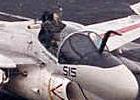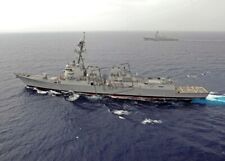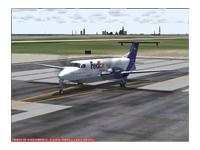The remarkable story of bombardier/navigator Lt. Keith Gallagher whose  ejection seat accidentally deployed during flight. He was partially ejected, pushed through the canopy, and became stuck with the upper half of his body exposed to the rushing air outside of the plane. The pilot managed to slow down the A-6 jet and land on the aircraft carrier from which the flight originated and it was a miracle that Gallagher survived.
ejection seat accidentally deployed during flight. He was partially ejected, pushed through the canopy, and became stuck with the upper half of his body exposed to the rushing air outside of the plane. The pilot managed to slow down the A-6 jet and land on the aircraft carrier from which the flight originated and it was a miracle that Gallagher survived.
The story is true and took place in the Indian Ocean in 1991 during operations from the aircraft carrier U.S.S. Abraham Lincoln. The story is chronicled on a website at http://www.gallagher.com/ejection_seat/.
Lieutenant Mark Baden’s (pilot) Account of the Incident:
As we finished the brief, my BN (bombardier navigator – Keith Gallagher)told me that it was his birthday and that our recovery would be his100thtrap on the boat. To top it off, we were assigned the plane with my name on the side. As we taxied out of the chocks, I was still feeling a little uneasy about all the recent mishaps. To make myself feel better, I went through the “soft shot/engine failure on takeoff” EPs (emergency procedures), touching each switch or lever as I went through the steps.
“At least if something happens right off the bat, I’ll be ready,” I thought. The first few minutes of the hop were busy. Concentrating on the package-check and consolidation, as well as trying to keep track of my initial customers, dispelled my uneasiness. As we approached mid-cycle, that most boring time in a tanker hop, we kept ourselves occupied with fuel checks. We were keeping a close eye on one drop tank that had quit transferring with about 1,000 pounds of fuel still inside. I had tried going to override on the tank pressurization, but that didn’t seem to work. My BN and I discussed the problem. We decided it was probably a stuck float valve.
Perhaps some positive and negative G would fix it. We were at 8,000feet, seven miles abeam the ship, heading aft. I clicked the altitude hold off and added some power to give us a little more G. At 230 knots I pulled the stick back and got the plane five degrees nose up. Then I pushed the stick forward. I got about half a negative G, just enough to float me in the seat. I heard a sharp bang and felt the cockpit instantly depressurize.
The roar of the wind followed. I ducked instinctively and looked up at the canopy expecting it to be partly open. Something was wrong. Instead of seeing a two or three inch gap, the canopy bow was flush with the front of the windscreen. My eyes tracked down to the canopy switch. It was up. Moment of impact my scan continued right. Instead of meeting my BN’s questioning glance, I saw a pair of legs at my eye level. The right side of the canopy was shattered. I followed the legs up and saw the rest of my BN’s body out in the wind blast.
I watched as his head snapped down and then back up, and his helmet and oxygen mask disappeared. They didn’t fly off; they just disappeared. My mind went into fast forward. “What the hell happened?” I wondered. “I hope he ejects all the way. What am I going to do now? I need to slow down.
” I jerked the throttles to idle and started the speed brakes out. Without stopping, I reached up, de-isolated, and threw the flap lever to the down position. I reached over and grabbed for the IFF selector switch and twisted it to EMER. I was screaming “Slow down! Slow down!” to myself as I looked up at the airspeed indicator and gave another pull back on the throttles and speed brakes. The airspeed was passing 200 knots. I had been looking back over my shoulder at my bombardier the whole time I was doing everything else.
I felt a strange combination of fear, helplessness and revulsion as I watched his body slam around in the wind blast. After his helmet flew off, his face looked like the people who get sucked out into zero atmosphere in some of the more graphic movies. His eyes were being blasted open, his cheeks and lips were puffed out to impossible size and the tendons in his neck looked like they were about to bust through his skin as he fought for his life. At 200 knots I saw his arms pulled up in front of his face and he was clawing behind his head. For a moment, I thought he was going to manage to pull the handle and get clear of the plane. I was mentally cheering for him. His arms got yanked down by the blast and I cursed as I checked my radio selector switch to radio 1.”Mayday, Mayday, this is 515. My BN has partially ejected.
I need an emergency pull-forward!” The reply was an immediate, “Roger, switch button six.” I switched freqs and said (or maybe yelled), “Boss (Air Officer), this is 515. My BN has partially ejected. I need an emergency full-forward!” I slapped the gear handle down and turned all my dumps on (in an effort to get slower, max trap never crossed my mind).
The Boss came back in his ever-calm voice and said, “Bring it on in.” Checking out the BN as I watched, the indexers move from on-speed to a green chevron I worked the nose to keep the plane as slow as possible and still flying. The plane was holding at around 160 knots and descending.
My BN’s legs were kicking, which gave me some comfort; he was not dead. But, watching his head and body jerked around in the wind blast, being literally beaten to death, made me ill. I had been arcing around in my descent and was still at seven miles.
The boss came up and asked if the BN was still with the aircraft. I think that I caused a few cases of nausea when I answered, “Only his legs are still inside the cockpit.” It made sense to me, but more than a few people who were listening had visions of two legs and lots of blood and no body. Fortunately, the Boss understood what I meant. As I turned in astern the boat, I called the Boss and told him I was six miles behind the boat.
I asked how the deck was coming. He asked if I was setting myself up for a straight-in. I told him “yes.” He told me to continue. It was then I noticed that my BN had quit kicking. A chill shot through my body and I looked back at him. What I saw scared me even more. His head was turned to the left and laying on his left shoulder. He was starting to turn grey. Maybe he had broken his neck and was dead. Bringing back a body that was a friend only minutes before was not a comfortable thought.
I forced myself not to look at my bombardier after that. The front windscreen started to fog up about four miles behind the boat. I cranked the defog all the way and was getting ready to unstrap my shoulder harness so I could wipe off the glass when it finally started clearing.
I saw the boat making a hard left turn. I made some disparaging remarks about the guys on the bridge as I rolled right to chase centerline. I heard CAG paddles (landing signal officer) come up on the radio. He told the captain he would take the winds and that he needed to steady up. My tension eased slightly as I saw mother begin to leave her wake in a straight line.
Coming in for landing I was driving it in at about 300 feet. I had been in a slight descent and wasn’t willing to add enough power to climb back up to a normal straight-in altitude for fear I would have to accelerate and do more damage to my already battered BN. I watched the ball move up to red and then move slowly up towards the center.
Paddles called for some rudder and told me not to go high. My scan went immediately to the 1-wire.I had no intention of passing up any “perfectly good wires.” I touched down short of the 1-wire and sucked the throttles to idle. The canopy shards directly in front of the BN’s chest looked like a butcher’s knife collection. I was very concerned that the deceleration of the trap was going to throw him into the jagged edge of the canopy. I cringed when I didn’t immediately feel the tug of the wire.
I pulled the stick into my lap as paddles was calling for altitude. I got the nose gear off the deck and then felt the hook catch a wire. I breathed a sigh of relief.
Testing the spool-up time of a pair of J-52s as I rolled off the end of the angle was not the way I wanted to end an already bad hop. As soon as I stopped, I set the parking brake and a yellow shirt gave me the signal to kill my No. 2 engine. Immediately after that, I heard a call over the radio that I was chocked. I killed no. 1 and began unstrapping.
As soon as I was free of my seat (I somehow remembered to safe it), I reached over and safed the BN’s lower handle, undid his lower koch fittings and reached up to try to safe his upper handle. As I was crawling up, I saw that his upper handle was already safed. I started to release his upper koch fittings but decided they were holding him in and I didn’t want him to fall against the razor-sharp Plexiglas on his side. I got back on my side of the cockpit, held his left arm and hand, and waited for the medical people to arrive.
I realized he still was alive when he said, “Am I on the flight deck?” A wave of indescribable relief washed over me as I talked to him while the crash crew worked to truss him up and pull him out of the seat. Once he was clear of the plane, they towed me out of the landing area and parked me.
A plane captain bumped the canopy open by hand far enough that I could squeeze out. I headed straight for medical without looking back at the plane. Later, I found that ignorance can be bliss.
I didn’t know two things while I was flying. First, the BN’s parachute had deployed and wrapped itself around the tail section of the plane. Second, the timing release mechanism had fired and released the BN from the seat.
The only things keeping him in the plane were the parachute risers holding him against the back of the seat.




































